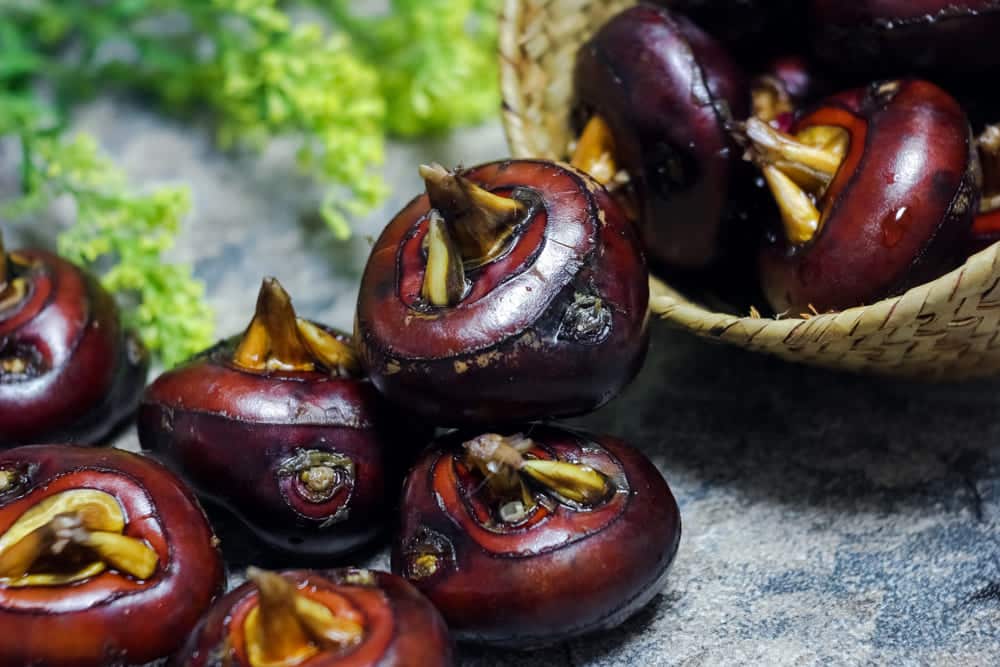
Vegetables are an important part of the diet, but many people don’t understand the importance of eating vegetables. Still, there are some amazing veggies out there with a mild flavor, such as water chestnuts. On the contrary, if you don’t have access to water chestnut, but if your recipe needs it, we are sharing the substitutes for water chestnut!
Substitutes For Water Chestnut
The water chestnut is popular in China, Korea, Japan, and Southeast Asia. As the name suggests, the water chestnuts are grown in water. Many people think that water chestnut is a nut, but it’s the tuber. Water chestnuts have a dark brown appearance (skin), which has to be peeled for taking out the crispy flesh (the flesh of the water chestnut is white).
There are different versions of water chestnuts available out there, such as Chinese water chestnuts and European water chestnuts. These are grown in fresh water and have the shape of turnips. These are usually planted at the bottom of streams or ponds. As for harvesting, it is harvested with forks. Usually, water chestnuts are used with bacon appetizers and stir-fries.
In addition, it can also be added to adding crunch to dips. That being said, it will add a creamy and distinct flavor to the dishes. For the most part, water chestnuts are added in the end and have a high nutritional count. So, if you cannot find out the water chestnuts, we are sharing the substitutes!
1) Turnip
In case you don’t have water chestnuts, you can always opt for turnips. The turnips are easily available in the supermarkets and are extremely cheap. It can be cooked with beets and potatoes. Turnip is the root vegetable that is native to eastern Asia. In case you’ve to use turnip as a substitute for water chestnut, you have to cut it down into pieces.
It can be cooked with salt, water, and oil. Also, the sliced turnips can be covered with the pan’s lid and is cooked until it’s soft. It can substitute water chestnut in Eastern cuisine. In case you are thinking about the flavor, it has a mild spicy flavor. On the contrary, the ripened turnips will have a mustard-like flavor that mellows down upon cooking.
2) Canned Water Chestnuts
If you are unable to find freshwater chestnuts, you can opt for canned water chestnuts. The canned water chestnuts are readily available in grocery stores. The canned water chestnuts have a similar flavor profile as the freshwater chestnuts. However, the nutty flavors are higher in fresh water chestnuts. Practically, they are the same, so the substitution is easy.
3) Jerusalem Artichokes
The Jerusalem artichokes are derived from sunflower. This is the tuber with brown skin and a lumpy appearance. For the most part, it looks like ginger. As far as the flavor is concerned, Jerusalem Artichokes have the sweet and nutty flavor with white flesh. In addition, it has a higher iron content with a crunchy texture.
If you want to substitute Jerusalem artichokes with water chestnuts, you have to use similar amounts.
4) Jicama Slices
In the first place, jicama slices are the root vegetables with a golden-brown appearance (the skin). The skin is extremely thin, which makes it look papery. The interior has white flesh with higher starch content. Jicama slices are native to Mexico but are widely used in Asia. Jicama slices have a juicy profile with a nutty and sweet flavor.
For the most part, it is available in warmer countries, and the growing season is extremely long. For substituting purposes, you can use equal quantities. However, you can change the quantity according to your taste preference.
5) Almond Flour
In case you want the substitute for water chestnut flour, you can opt for almond flour. The almond flour will have a higher protein content and doesn’t have gluten. The almond flour can be made by blending and grounding the sweet almonds. In addition, it is available in grocery stores. However, it has a more granular texture, and the sweetness will be much less.
6) Hazelnut Flour
As the name suggests, hazelnut flour is made by grinding the raw hazelnuts. It makes a great substitute for water chestnut flour. It has a nutty flavor, but there is no grainy texture. The hazelnut flour is gluten-free and can be used in smoothies, fish, and chicken bread.